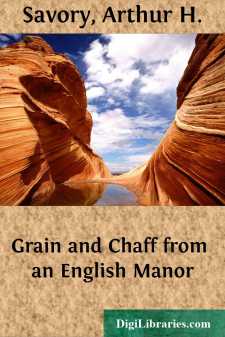Categories
- Antiques & Collectibles 13
- Architecture 36
- Art 48
- Bibles 22
- Biography & Autobiography 813
- Body, Mind & Spirit 142
- Business & Economics 28
- Children's Books 15
- Children's Fiction 12
- Computers 4
- Cooking 94
- Crafts & Hobbies 4
- Drama 346
- Education 46
- Family & Relationships 57
- Fiction 11828
- Games 19
- Gardening 17
- Health & Fitness 34
- History 1377
- House & Home 1
- Humor 147
- Juvenile Fiction 1873
- Juvenile Nonfiction 202
- Language Arts & Disciplines 88
- Law 16
- Literary Collections 686
- Literary Criticism 179
- Mathematics 13
- Medical 41
- Music 40
- Nature 179
- Non-Classifiable 1768
- Performing Arts 7
- Periodicals 1453
- Philosophy 64
- Photography 2
- Poetry 896
- Political Science 203
- Psychology 42
- Reference 154
- Religion 513
- Science 126
- Self-Help 84
- Social Science 81
- Sports & Recreation 34
- Study Aids 3
- Technology & Engineering 59
- Transportation 23
- Travel 463
- True Crime 29
Grain and Chaff from an English Manor
by: Arthur H. Savory
Categories:
Description:
Excerpt
CHAPTER I.
ALDINGTON VILLAGE—THE MANOR HOUSE—THE FARM.
"There's a divinity that shapes our ends."
—Hamlet.
"Deep-meadow'd, happy, fair with orchard lawns."
—Morte d'Arthur.
In recalling my earliest impressions of the village of Aldington, near Evesham, Worcestershire, the first picture that presents itself is of two chestnut-trees in full bloom in front of the Manor House which became my home, and their welcome was so gracious on that sunny May morning that it inclined me to take a hopeful view of the inspection of the house and land which was the object of my visit.
The village took its name from the Celtic Alne, white river; the Anglo-Saxon, ing, children or clan; and ton, the enclosed place. The whole name, therefore, signified "the enclosed place of the children, or clan, of the Alne." There are many other Alnes in England and Scotland, also Allens and Ellens as river names, probably corruptions of Alne, and we have many instances of the combination of a river name with ing and ton, such as Lymington and Dartington. The Celtic Alne points to the antiquity of the place, and there were extensive traces of Roman occupation to which I shall refer later.
The village was really no more than a hamlet ecclesiastically attached to the much larger village of Badsey. In addition to Celtic, Roman, and Anglo-Saxon associations, it figured before the Norman Conquest in connection with the Monastery and Abbey of Evesham, the Manor and the mill being mentioned in the Abbey records; and they were afterwards set down in Domesday Survey.
The Vale of Evesham, in which Aldington is situated, lies at the foot of the Cotswold Hills, and when approached from them a remarkable change in climate and appearance is at once noticeable. Descending from Broadway or Chipping Campden—that is, from an altitude of about 1,000 feet to one of 150 or less—on a mid-April day, one exchanges, within a few miles, the grip of winter, grey stone walls and bare trees, for the hopeful greenery of opening leaves and thickening hedges, and the withered grass of the Hill pastures for the luxuriance of the Vale meadows.
The earliness of the climate and the natural richness of the land is the secret of the intensive cultivation which the Vale presents, and year by year more and more acres pass out of the category of farming into that of market-gardening and fruit-growing. The climate, however, though invaluable for early vegetable crops, is a source of danger to the fruit. After a few days of the warm, moist greenhouse temperature which, influenced by the Gulf Stream, comes from the south-west up the Severn and Avon valleys, between the Malverns and the Cotswolds, and which brings out the plum blossom on thousands of acres, a bitter frost sometimes occurs, when the destruction of the tender bloom is a tragedy in the Vale, while the Hills escape owing to their more backward development....


